A high-contrast palette can turn the narrowest corridor into a show-stopping introduction to your home. By leaning on crisp lines, purposeful pattern, and strategic lighting, a black and white hallway gains depth, rhythm, and surprising warmth. Below you’ll find 20 ideas—each laser-focused on one smart move—that prove monochrome is anything but monotonous. Ready to let bold opposites meet in the middle of your house? Step this way.
1. Checkerboard Floor for Instant Drama
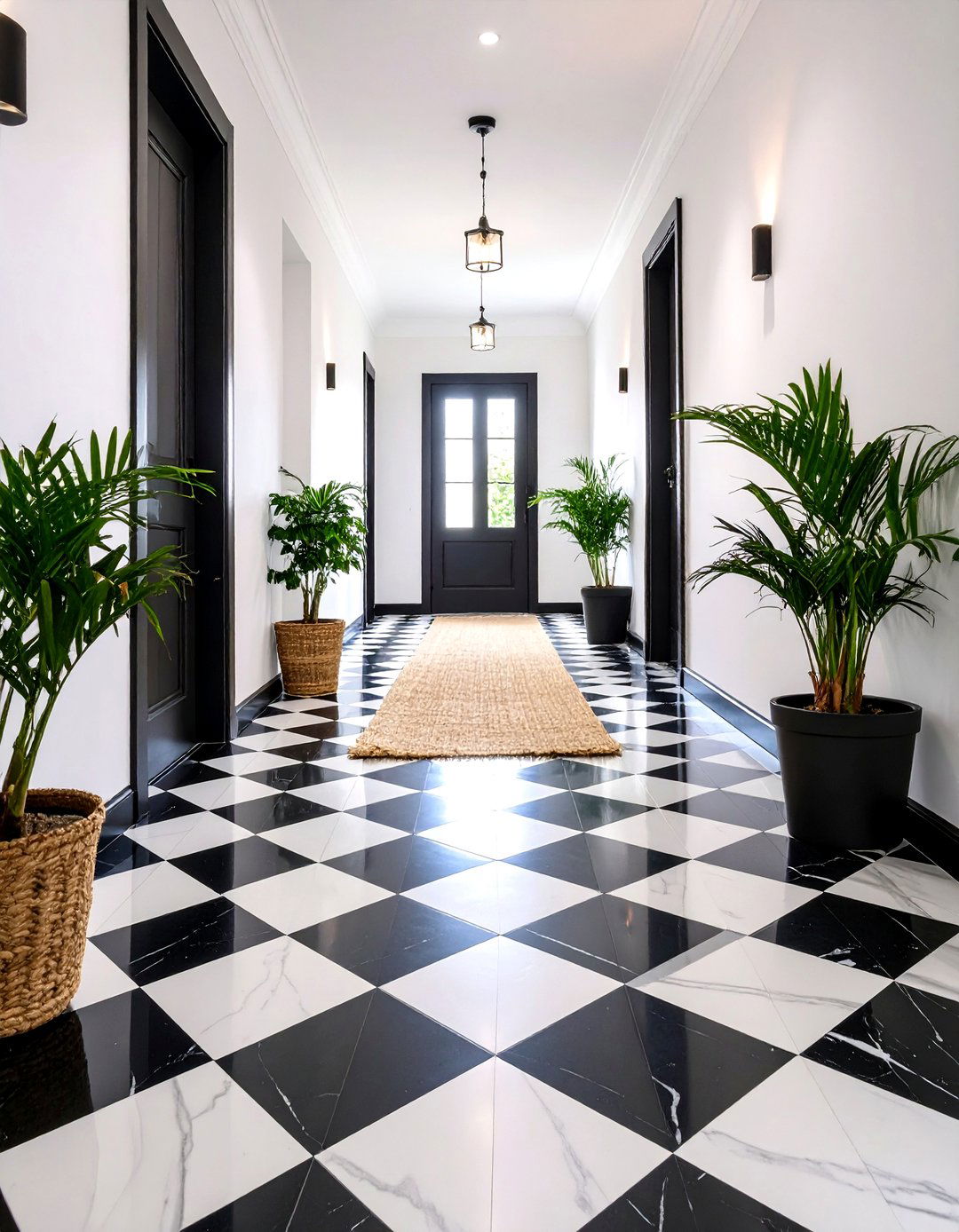
A classic checkerboard tile sets the tone the moment you cross the threshold, anchoring the hallway with a graphic motif that feels both vintage and current. Marble or porcelain squares laid on a 45-degree angle draw the eye forward, making tight spaces appear longer. Complement the floor with simple white walls and matte-black door hardware so the pattern remains the star. To soften the geometry, layer in a jute runner or a few potted plants; the natural texture keeps the monochrome from feeling stark while preserving the hallway’s crisp personality.
2. Vertical Striped Walls that Stretch Space
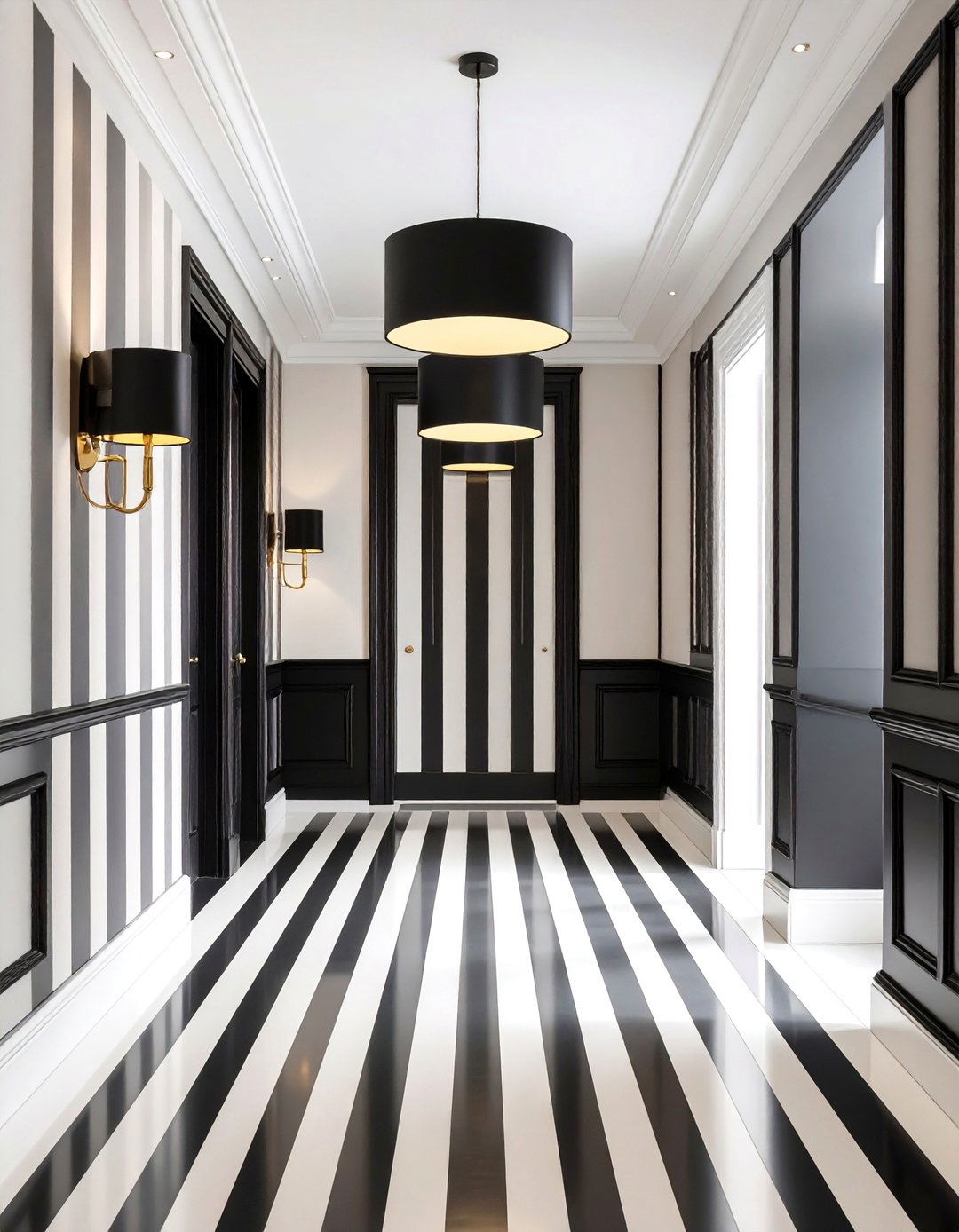
Bold, floor-to-ceiling stripes in alternating ebony and ivory visually raise the ceiling and lengthen the corridor—an optical trick designers swear by. Choose a satin finish so light bounces gently across the paint, and keep the stripe width consistent (four to six inches works in most homes). Finish the look with streamlined white baseboards and a slim black picture rail, allowing the pattern to read as tailored rather than dizzying. A single oversized sconce in matte black metal offers functional illumination without adding clutter.
3. Grid-Style Gallery Wall of Black Frames
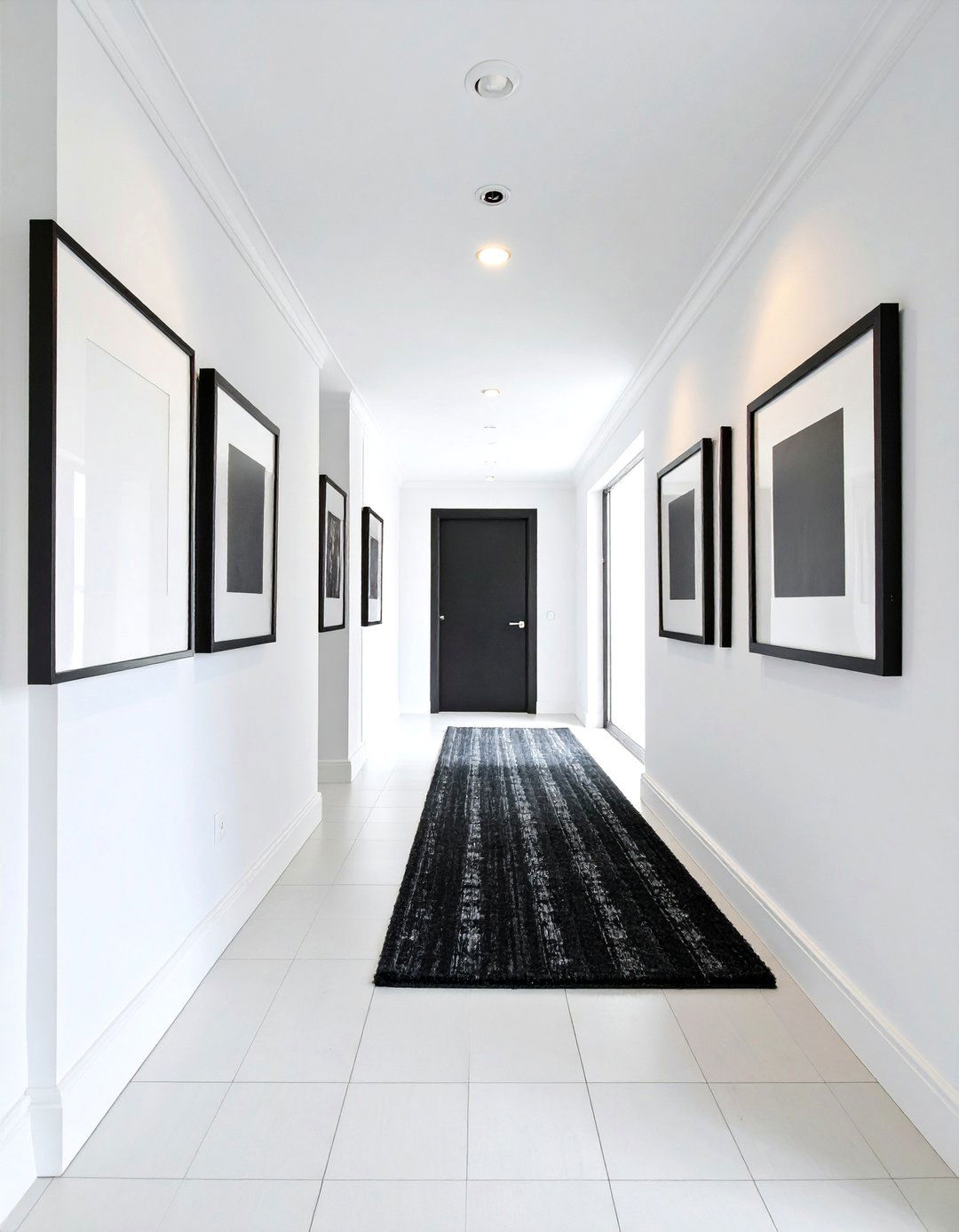
For hallway walls begging for personality, arrange black frames in a precise grid to create a museum-like gallery that celebrates family photos or monochrome art prints. Keep mats bright white to sharpen the contrast, and stick to consistent spacing—use a level and painter’s tape for crisp alignment. When the grid spans the full length of the hallway, it guides guests along the route like visual breadcrumbs. Underfoot, a plain wool runner lets the artwork shine while cushioning foot traffic.
4. Sculptural Pendant as a Monochrome Focal Point
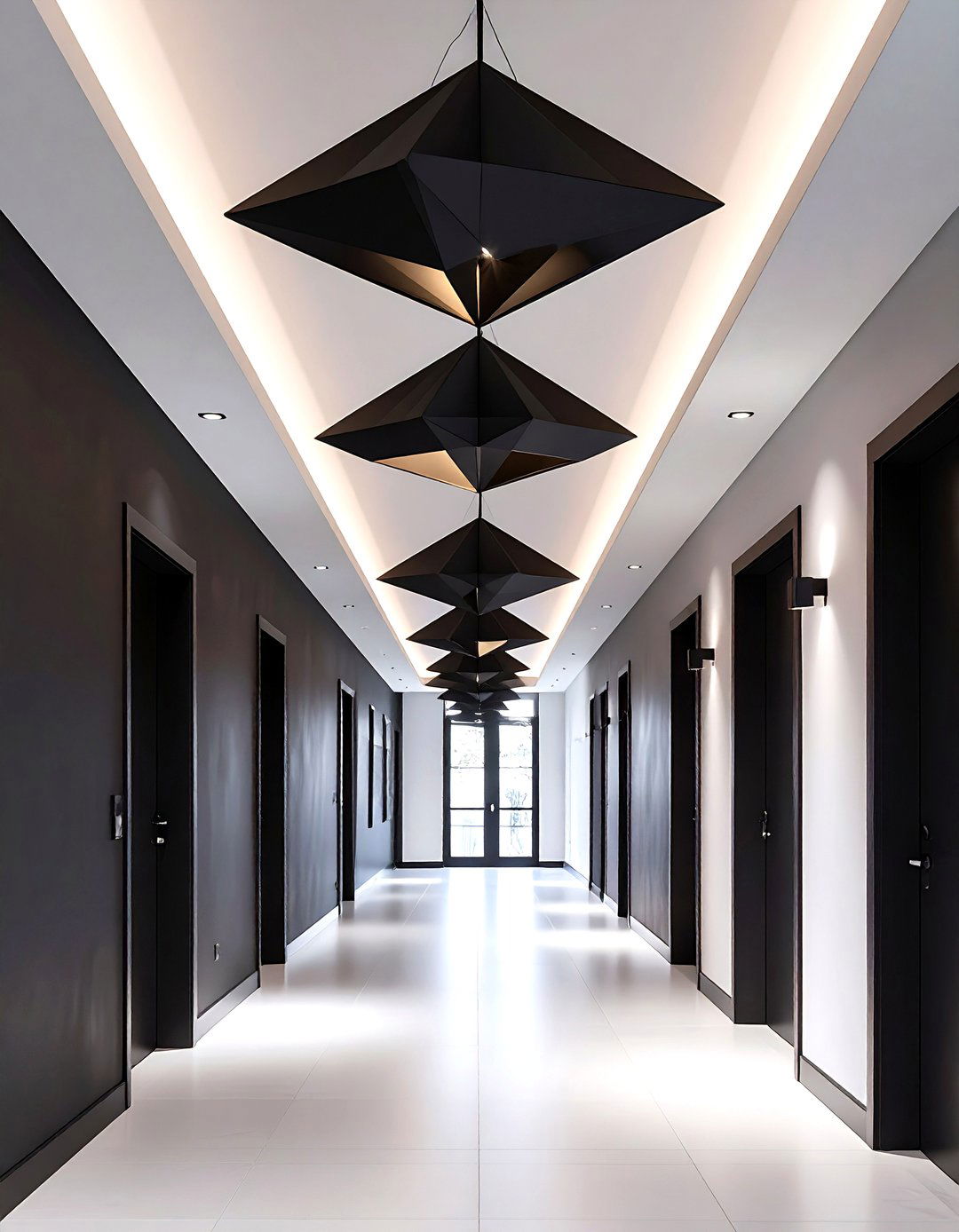
Suspending a single statement pendant—think oversized black globe or origami-style shade—injects sculpture into an otherwise linear hallway. Position the fixture about seven feet from the floor so it feels intentional rather than obstructive. A white ceiling amplifies the fixture’s silhouette, while recessed LED spots fill any shadowy corners. If your hallway runs long, identical pendants spaced evenly act like punctuation marks, leading the eye from one pool of light to the next.
5. Half-Height Wainscoting for Balanced Contrast
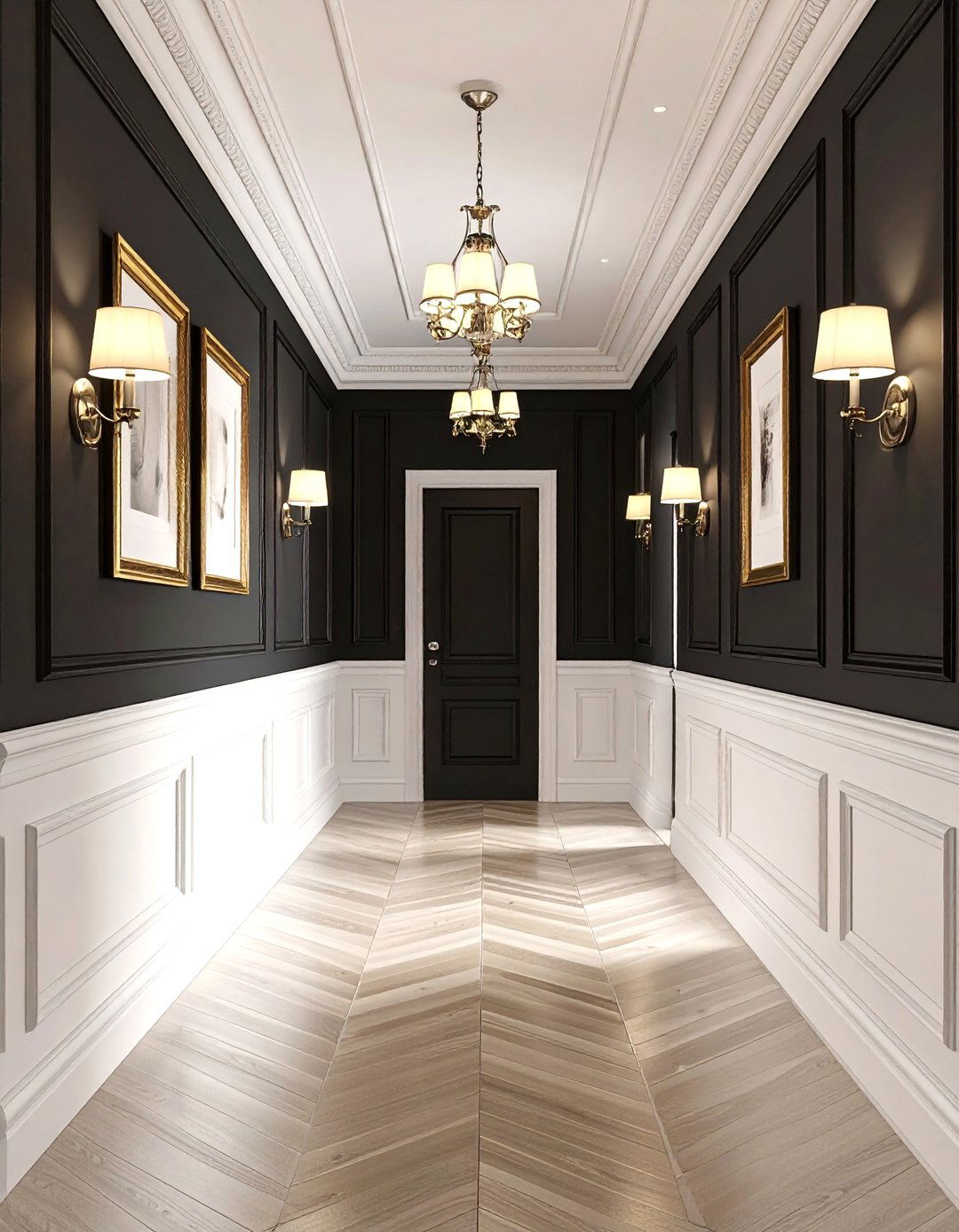
Painting panelled wainscoting bright white and the wall above midnight black carves a perfect equilibrium between light and dark. The lower panels protect high-traffic surfaces from scuffs, and the darker upper section cocoons the space. Crown moulding painted to match the top color finishes the transition cleanly. Add chrome picture lights over framed photography for a dash of gallery sophistication without overwhelming the restrained palette.
6. Graphic Runner Rug to Lead the Way
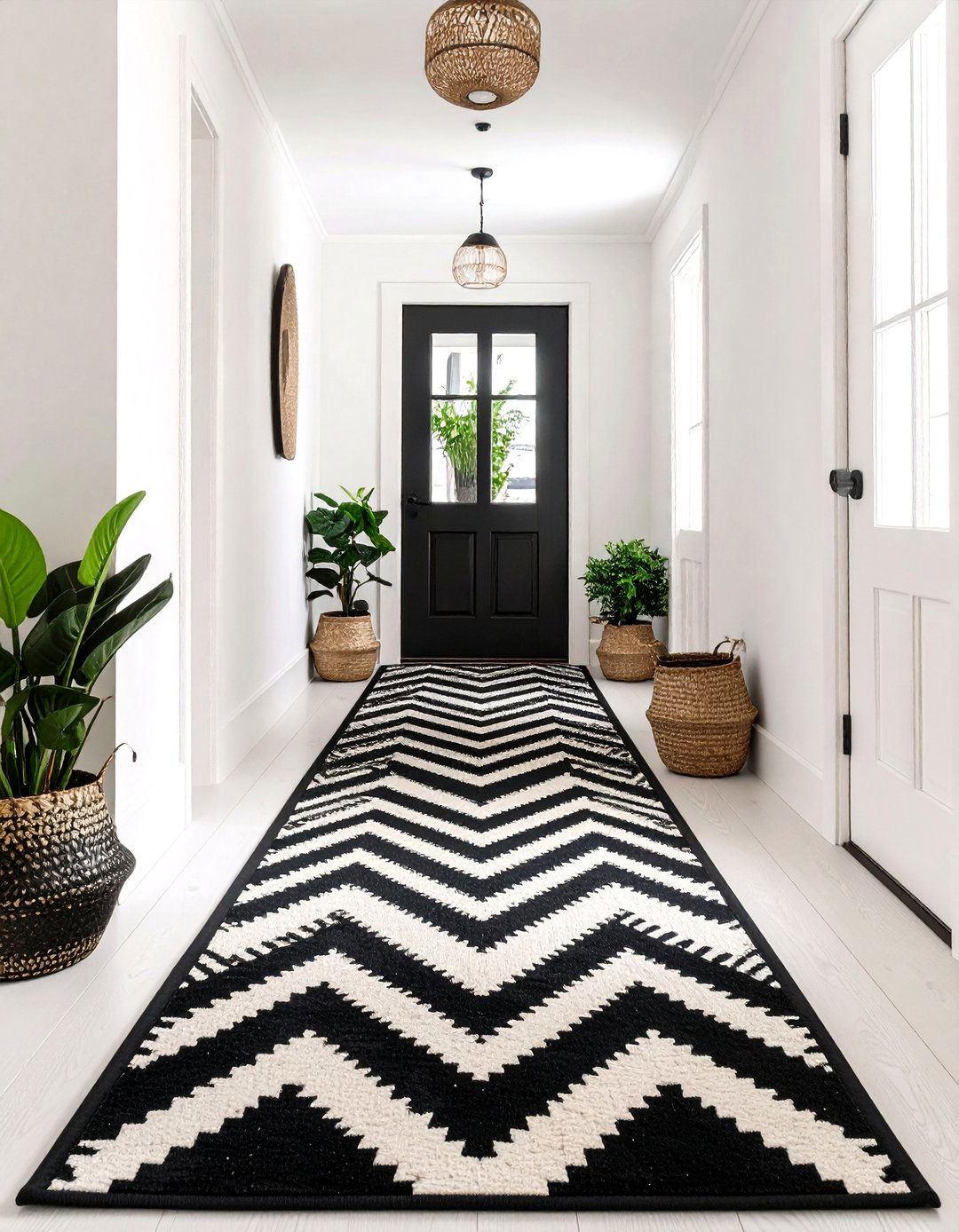
A narrow hallway begs for softness underfoot; choose a washable runner with a bold geometric repeat—chevrons, diamonds, or herringbone—in black and white. The long stripe of pattern visually lengthens the passage while absorbing sound. Balance the busy floor with solid walls and minimal furniture, or echo one of the rug’s shapes in a small accent, like a faceted vase on a console.
7. White Walls Paired with Black Doors
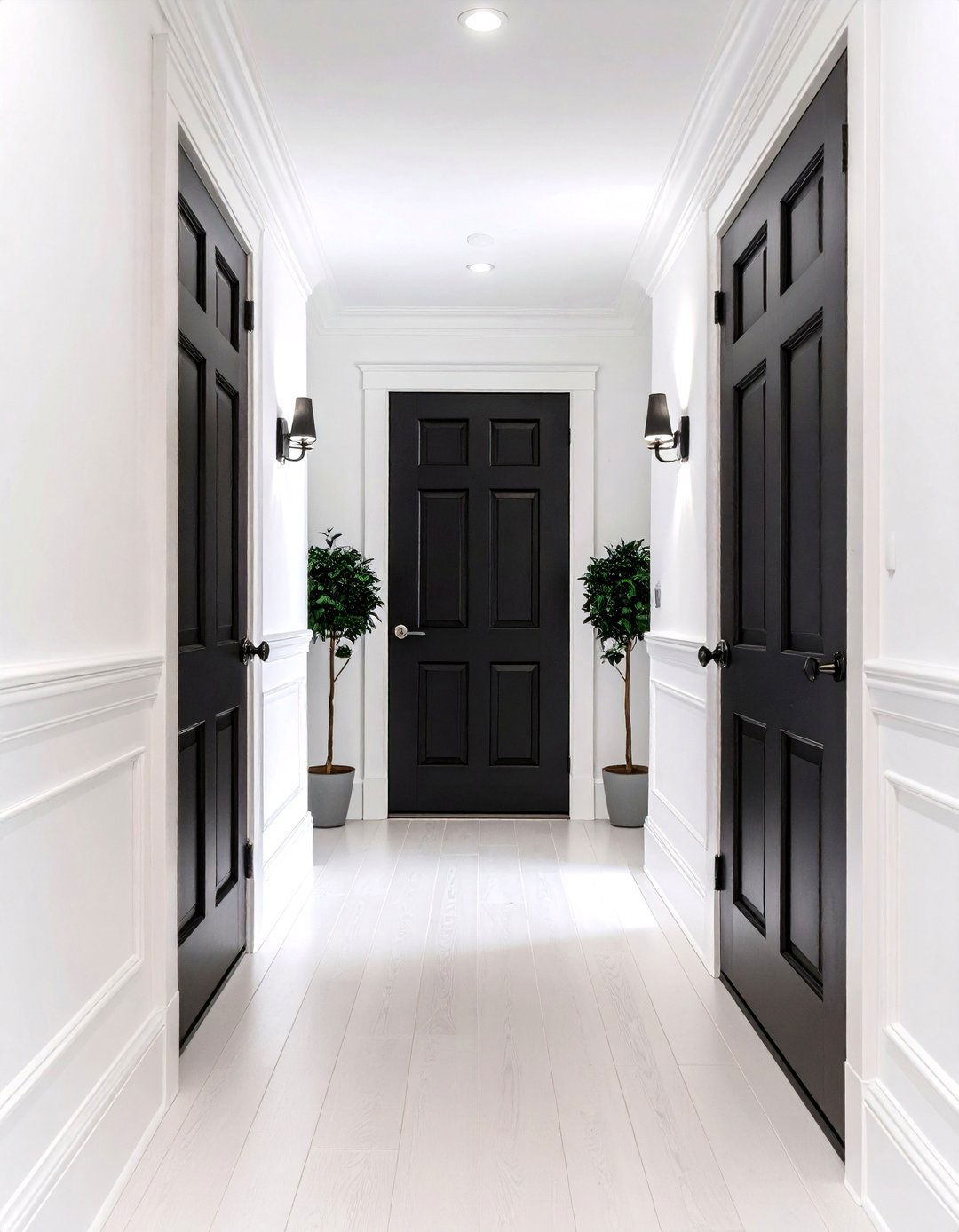
Swapping standard white doors for deep-black slabs turns every doorway into a dramatic portal against crisp white casing. This inversion steals almost no square footage yet feels architecturally significant. Satin nickel or unlacquered brass hardware pops against the dark backdrop, offering tactile contrast. Keep hinges painted to match the door for a seamless look, and install door stops to protect the fresh finish.
8. Staircase Contrast: Dark Rails, Light Risers

If your hallway merges with a stairwell, paint balusters and handrail glossy black while leaving treads and risers bright white. The crisp railing line acts like graphic ink on a page, and glossy paint resists fingerprints. Tie the palette together by framing stairway art in slim black frames and lining the landing with a small monochrome runner for continuity.
9. Chalkboard Accent Wall for Interactive Style
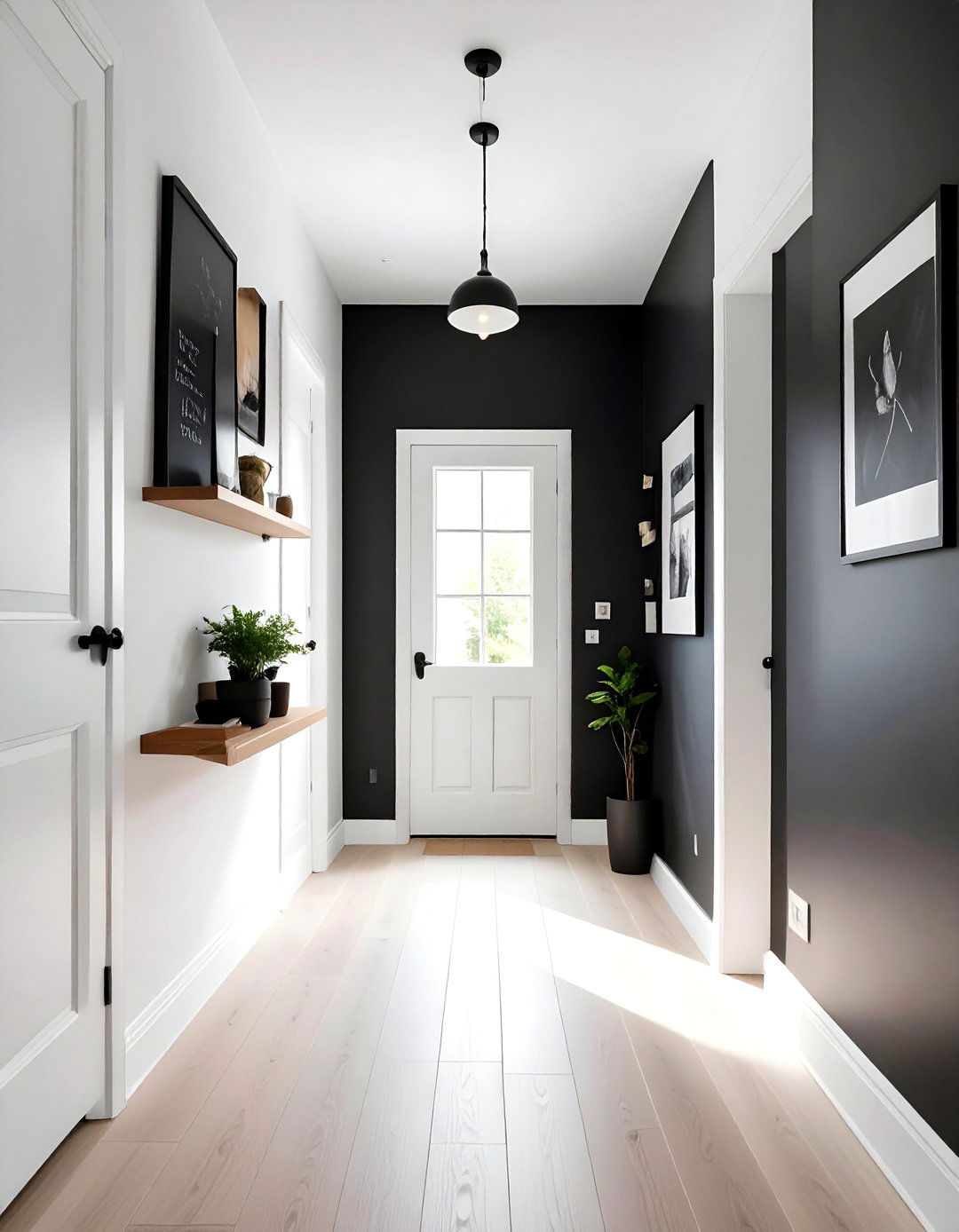
Coating one short hallway wall in black chalkboard paint invites playful doodles, grocery reminders, or inspiring quotes. Against surrounding white surfaces, the matte black finish adds depth without relying on decorative objects. Keep a small tray of chalk handy on a floating shelf, and seal neighboring trim with extra-durable enamel to deflect stray dust. A magnetic primer beneath the paint doubles the wall’s functionality.
10. Thin Black-Framed Mirrors to Double Light
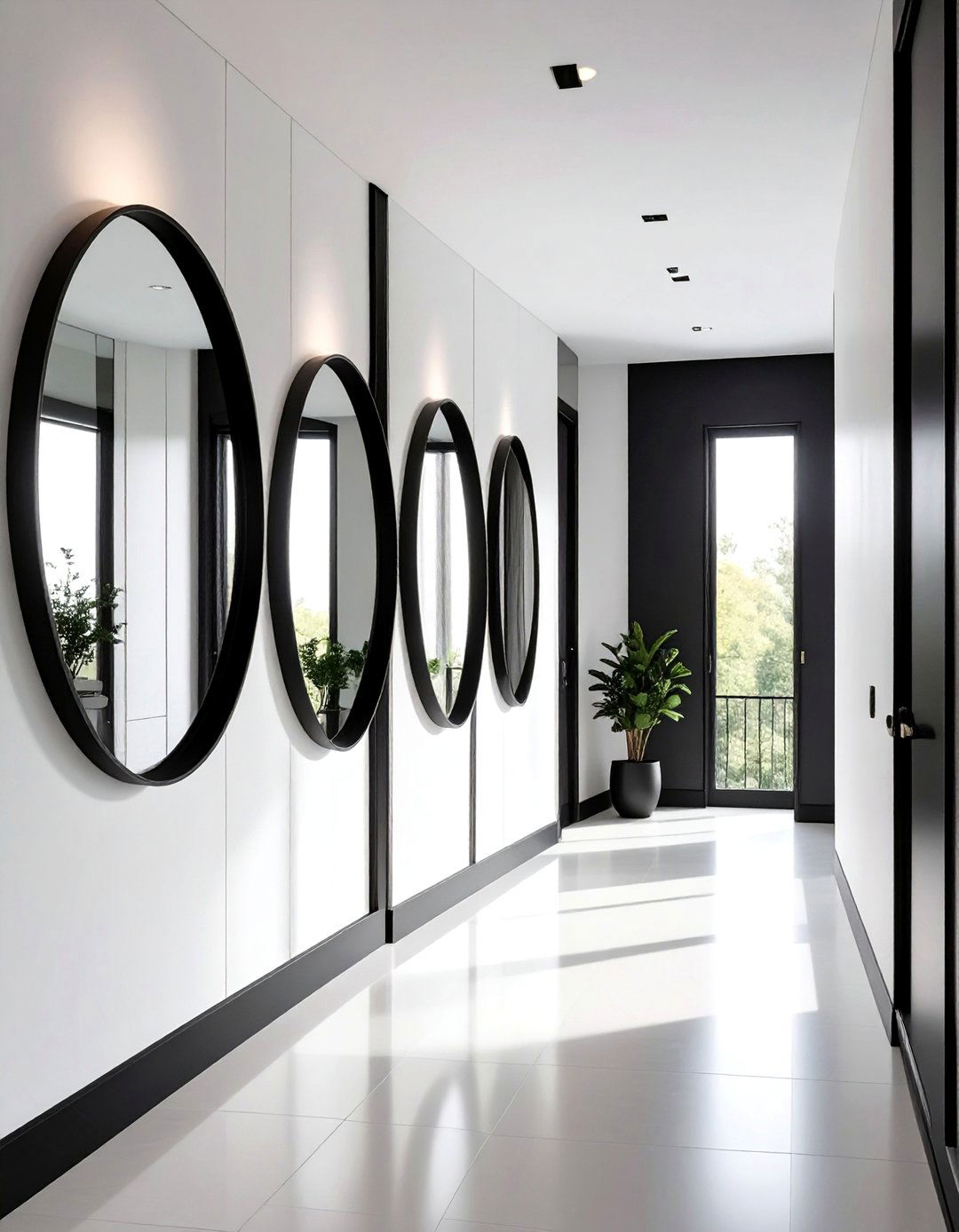
Long, narrow corridors crave reflection. Mounting a series of slim, black-framed mirrors creates the illusion of width and amplifies ambient light. Alternate rectangular and round shapes for subtle dynamism, or align identical mirrors edge-to-edge for a sleek runway effect. Position opposite a window or pendant so the brightest elements bounce throughout the space, reducing the need for additional fixtures.
11. Geometric Peel-and-Stick Wallpaper for Quick Impact
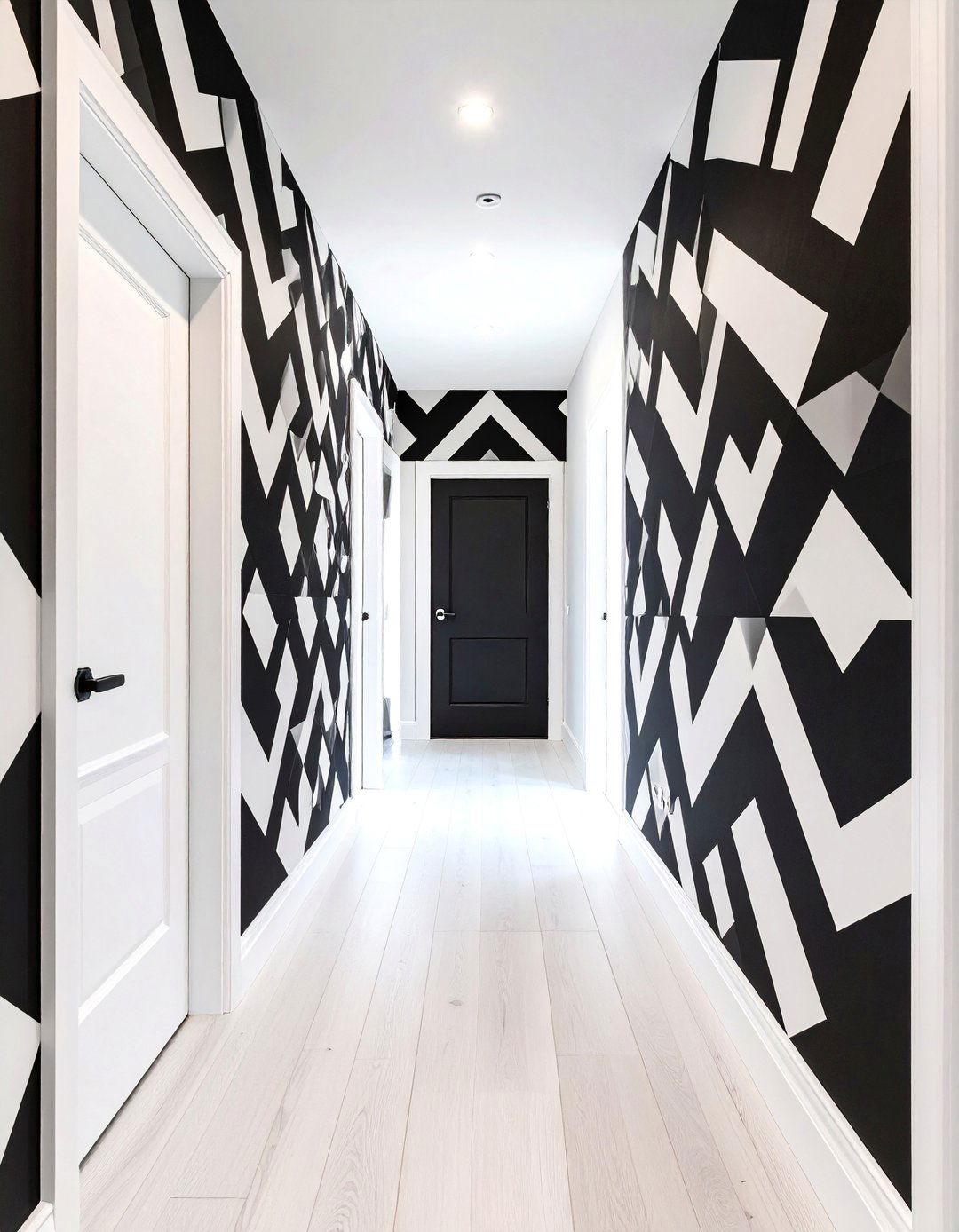
Removable wallpaper in bold monochrome geometry—triangles, interlocking cubes, or art-deco fans—lets renters embrace pattern without permanent commitment. Cover a single feature wall or wrap the entire hallway for immersive character. Because the palette stays neutral, you can layer color through seasonal accessories and switch them out at will. Smooth seams with a wallpaper brush for a professional finish.
12. Floating Black Console Against White Plaster

Mounting a slim black floating console halfway along the hallway provides a landing spot for keys without stealing floor area. The negative space underneath keeps sightlines open, while a white plaster or limewash backdrop accentuates the console’s sharp lines. Top it with a white ceramic bowl and a single sculptural branch for understated organic texture that tempers the stark palette.
13. Ink-Dark Architraves and Skirtings for Graphic Edges
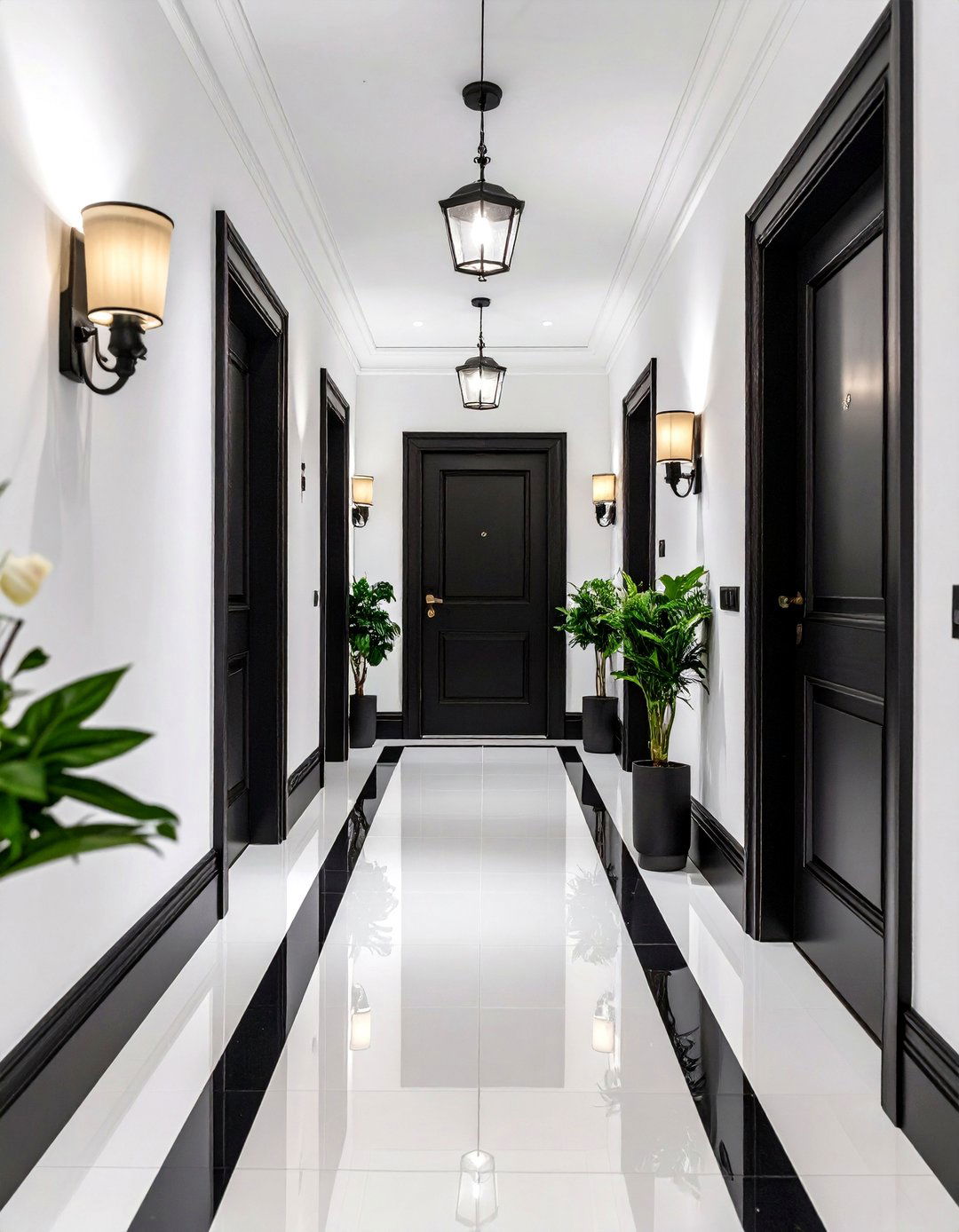
Instead of painting entire walls, try outlining doors, windows, and baseboards in black against white walls. The crisp edges frame each architectural element like artwork, giving even builder-grade trim a bespoke appearance. Use semi-gloss paint for durability, and carry the color onto stair stringers or loft hatch trims for total cohesion. Neutral artwork keeps the look refined rather than busy.
14. Two-Tone Paint Split Horizontally

Reserving black paint for the lower third of the wall and white for the upper two-thirds delivers grounding contrast while preserving light near eye level. A slender picture rail or chair rail covers the paint break, adding a subtle traditional detail. Finish with matching black socket covers so electrical points disappear into the darker zone, reinforcing the uninterrupted band.
15. Domino-Style Art Hung in a Linear Sequence
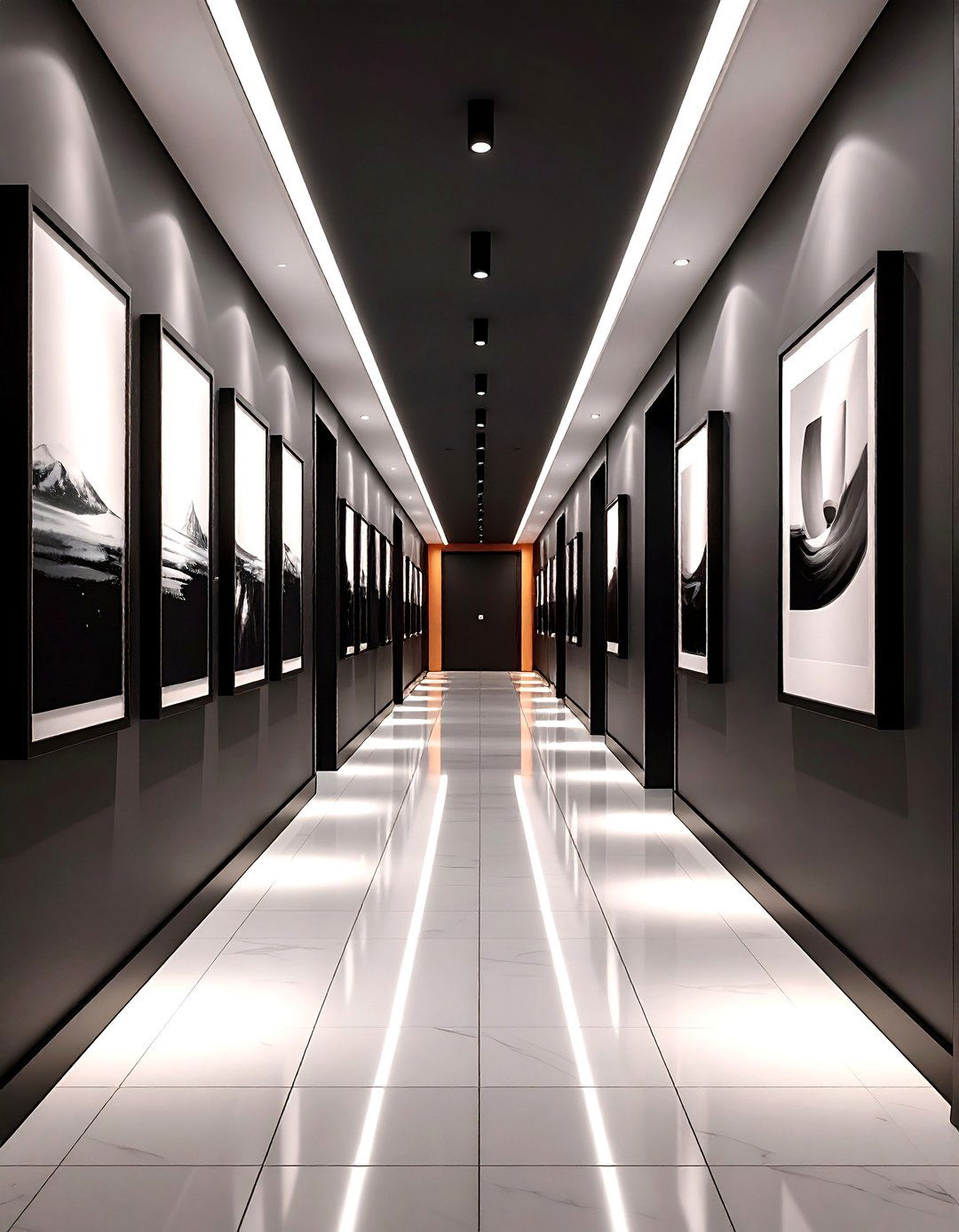
Arranging identical black-and-white prints at equal intervals—just like domino tiles—along the hallway emphasizes forward motion. Keep frames thin and mats generous so each piece feels airy despite the strong colorway. A concealed LED strip above the row washes artwork in gentle light, ensuring evening drama without glare.
16. Monochrome Plant Stands for Lively Contrast
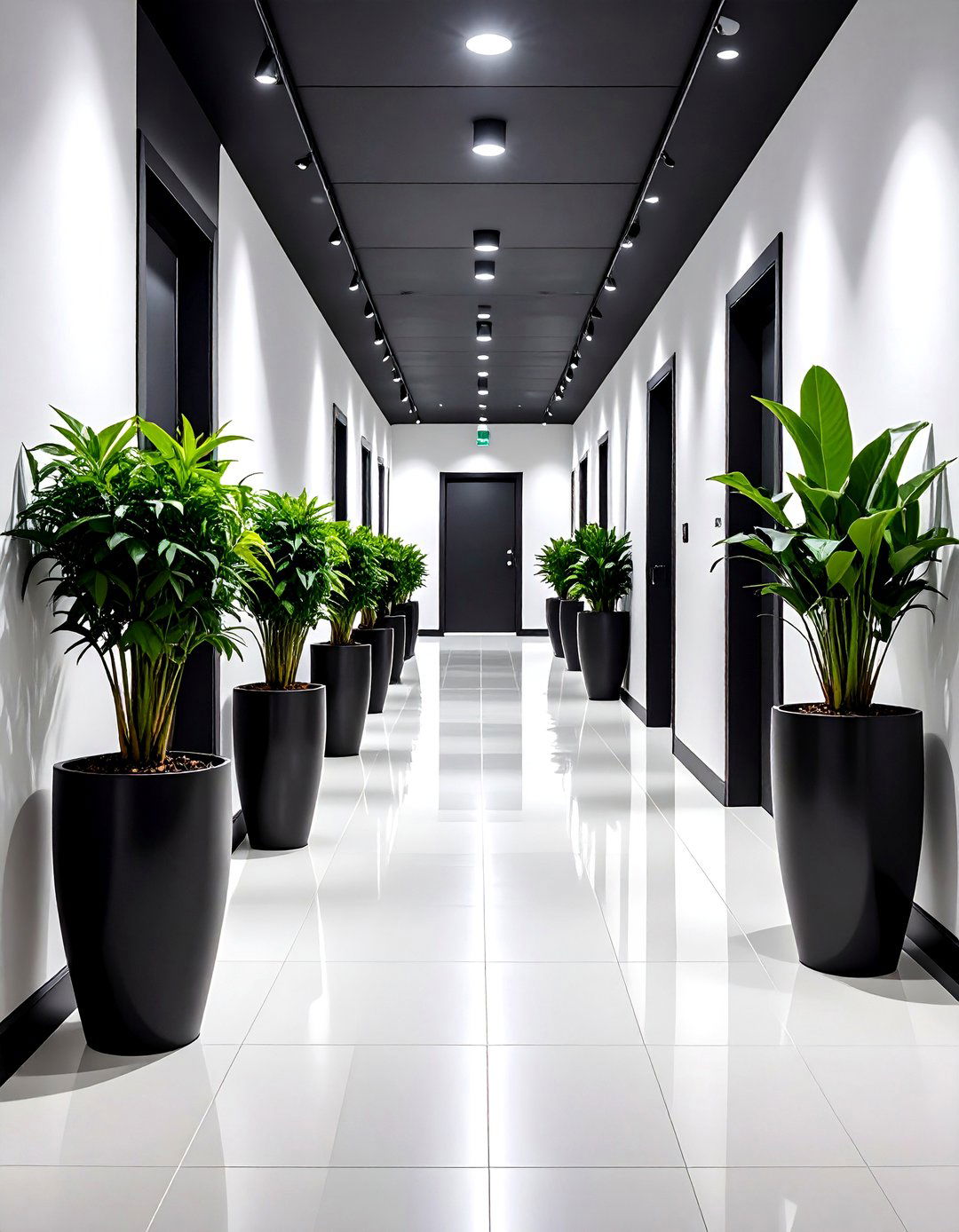
Punctuate the corridor with leafy greenery perched on alternating black and white stands. The organic shapes soften hard lines while echoing the palette. Opt for plants that tolerate low light—snake plants or ZZ plants—to ensure longevity. A coat of matte black paint on terracotta pots unifies the look and prevents visual clutter.
17. Storage Bench in a Striking Cow-Hide Print
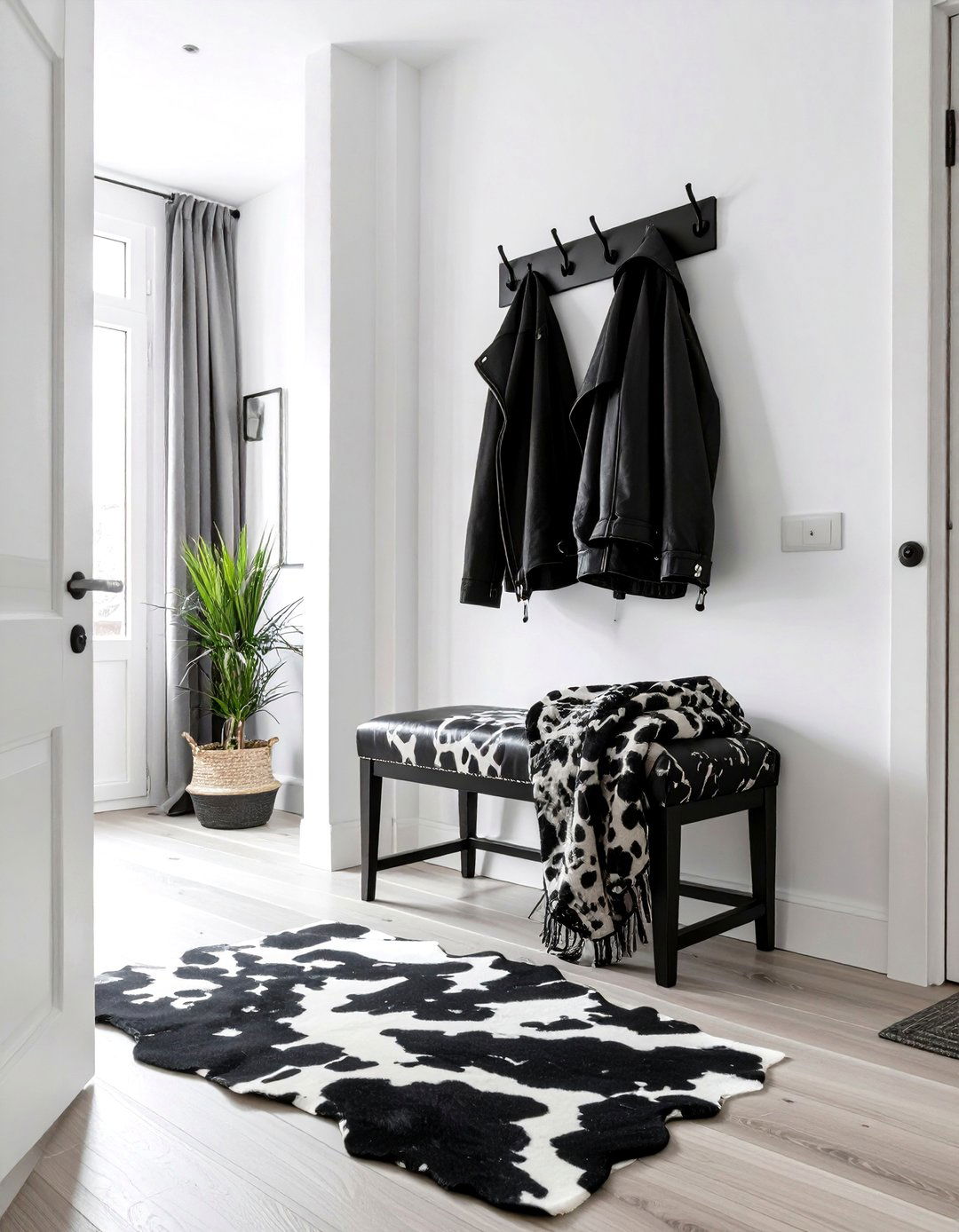
An upholstered bench in black-and-white pattern offers a convenient perch for putting on shoes and hides scarves inside its lift-top compartment. Place it under a row of black hooks so jackets and totes stay organized. A monochrome throw draped casually across the seat injects softness, while tapered wooden legs keep the piece from feeling bulky.
18. Layered Lighting with Sleek Wall Sconces
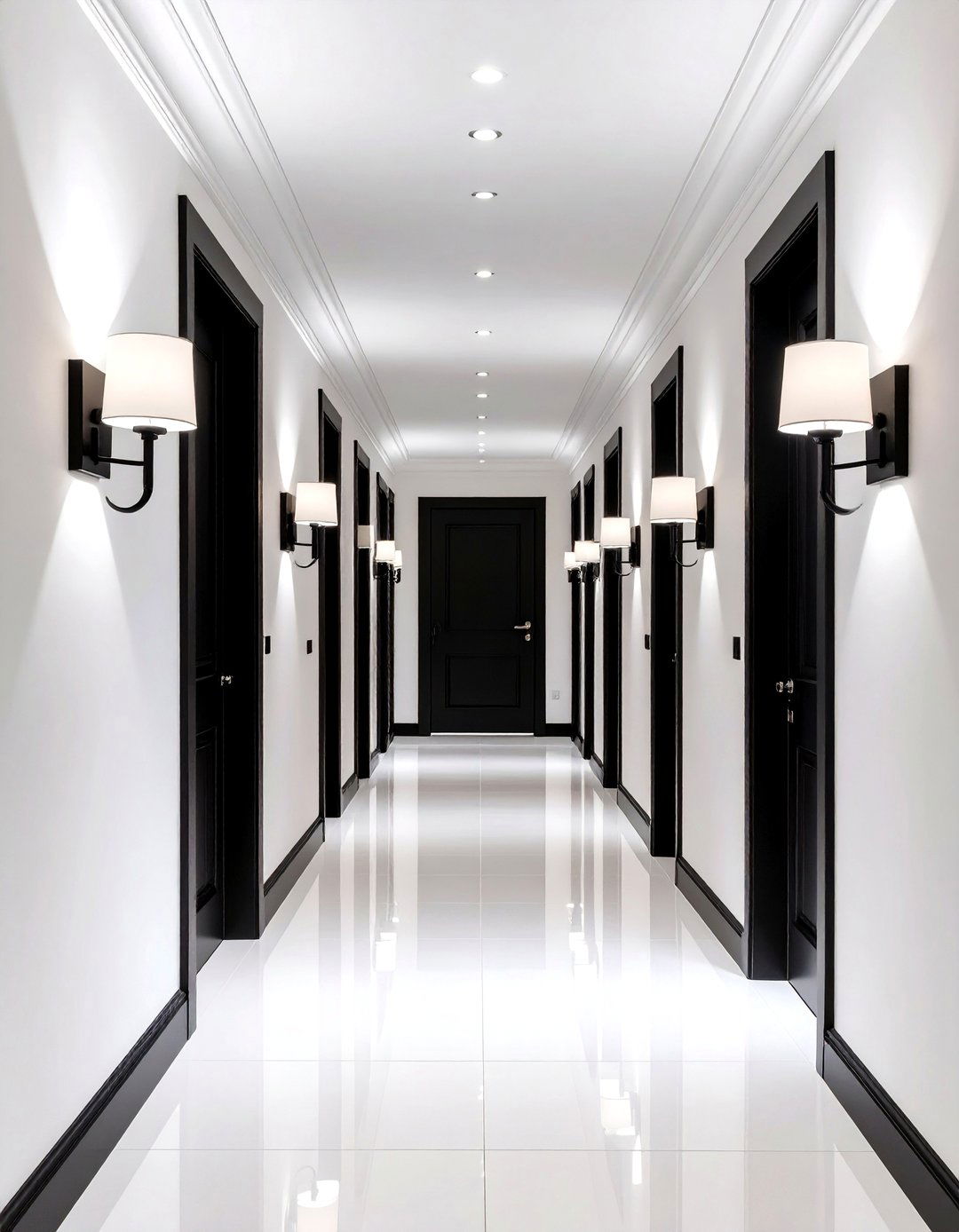
Pairing minimalist black sconces with discreet recessed downlights layers illumination, eliminating shadows common in narrow halls. Select sconces with white glass shades to diffuse glow softly against dark walls. Install a dimmer to shift from functional brightness to evening ambience, and mirror the sconce finish in nearby door hardware for cohesion.
19. High-Gloss Black Floorboards Under White Walls
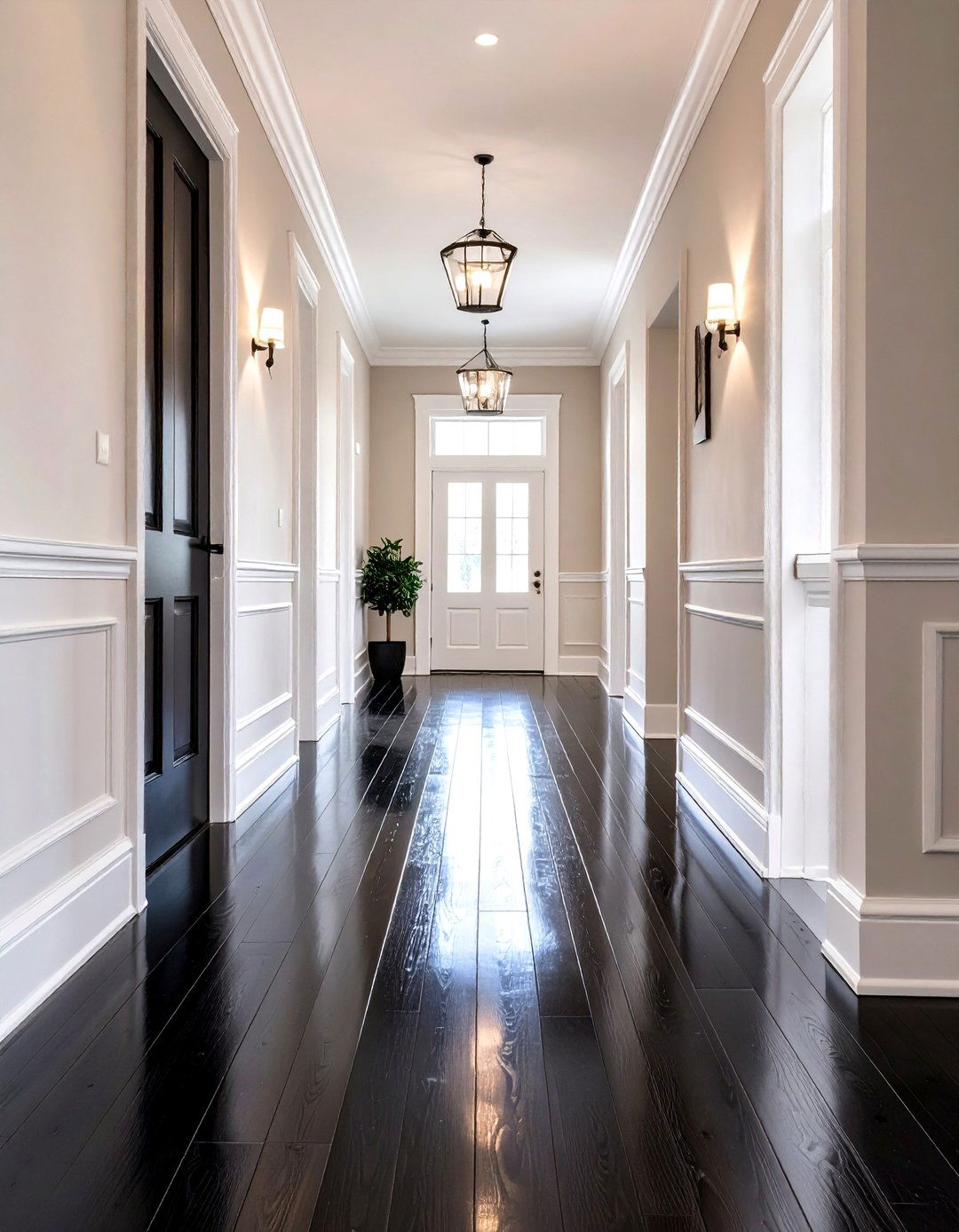
Painting existing timber floorboards in high-gloss black lacquer elevates humble planks, bouncing reflections up pale walls and effectively lighting the space without extra fixtures. Apply a durable polyurethane topcoat to resist shoe scuffs, and run a crisp white quarter-round along the edges for a tailored transition between floor and wall.
20. Matte Walls, Glossy Tiles: A Textural Mix

Combining chalky matte wall paint with high-shine white subway tiles at shoulder height introduces tactile contrast that keeps an all-neutral hallway engaging. The tiles’ reflective surface catches light from a pendant, while the matte finish absorbs glare, balancing the sensory experience. Finish with a slim black ledge atop the tile line for postcards or small framed prints.
Conclusion:
Black and white hallways thrive on deliberate contrast, disciplined pattern, and layered textures. Whether you commit to a timeless checkerboard floor, a sculptural pendant, or the subtle frame-and-skirting strategy, each idea above proves that monochrome can be both spirited and welcoming. Embrace one move or combine several, and watch your hallway transform from overlooked passage to confident style statement.


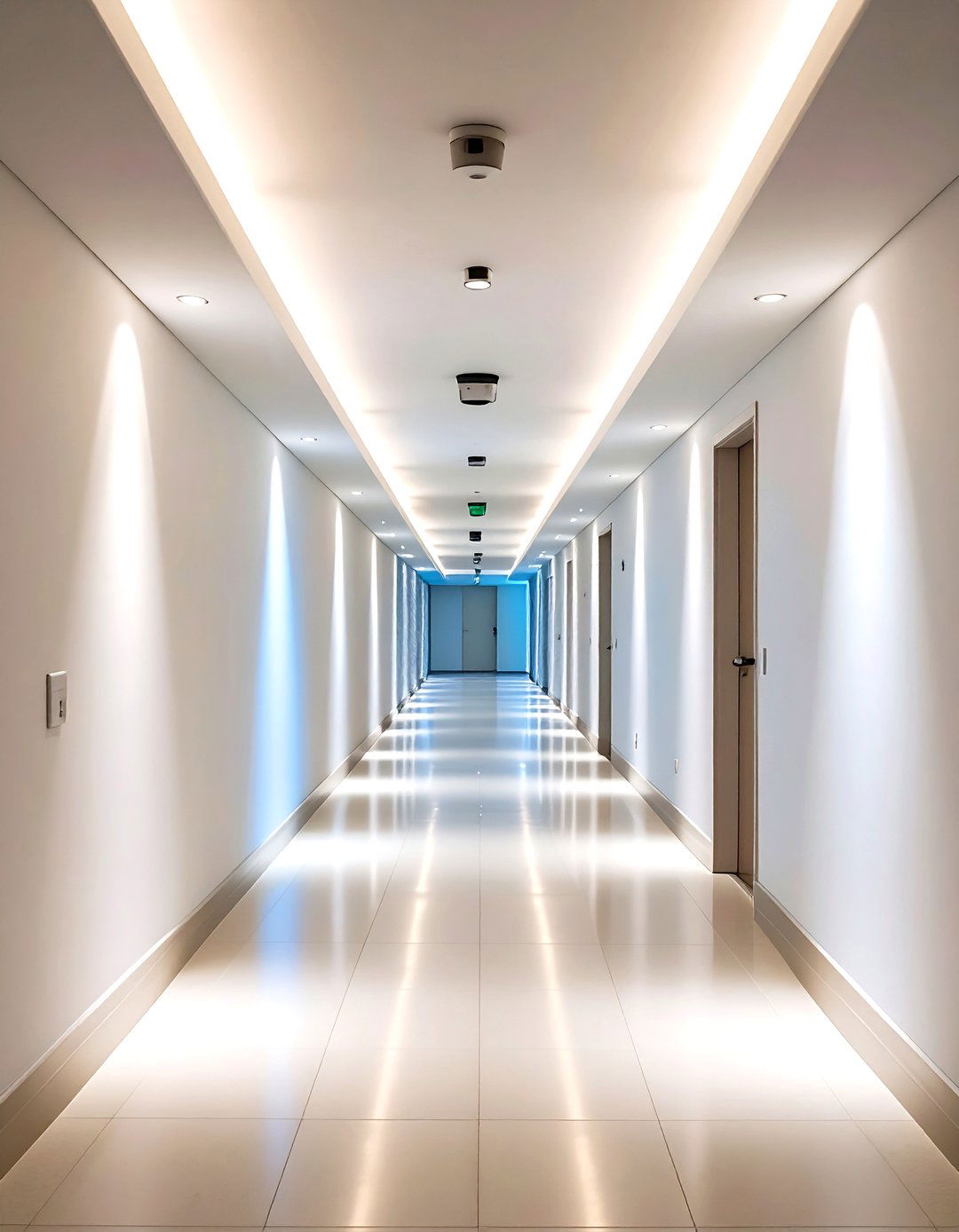
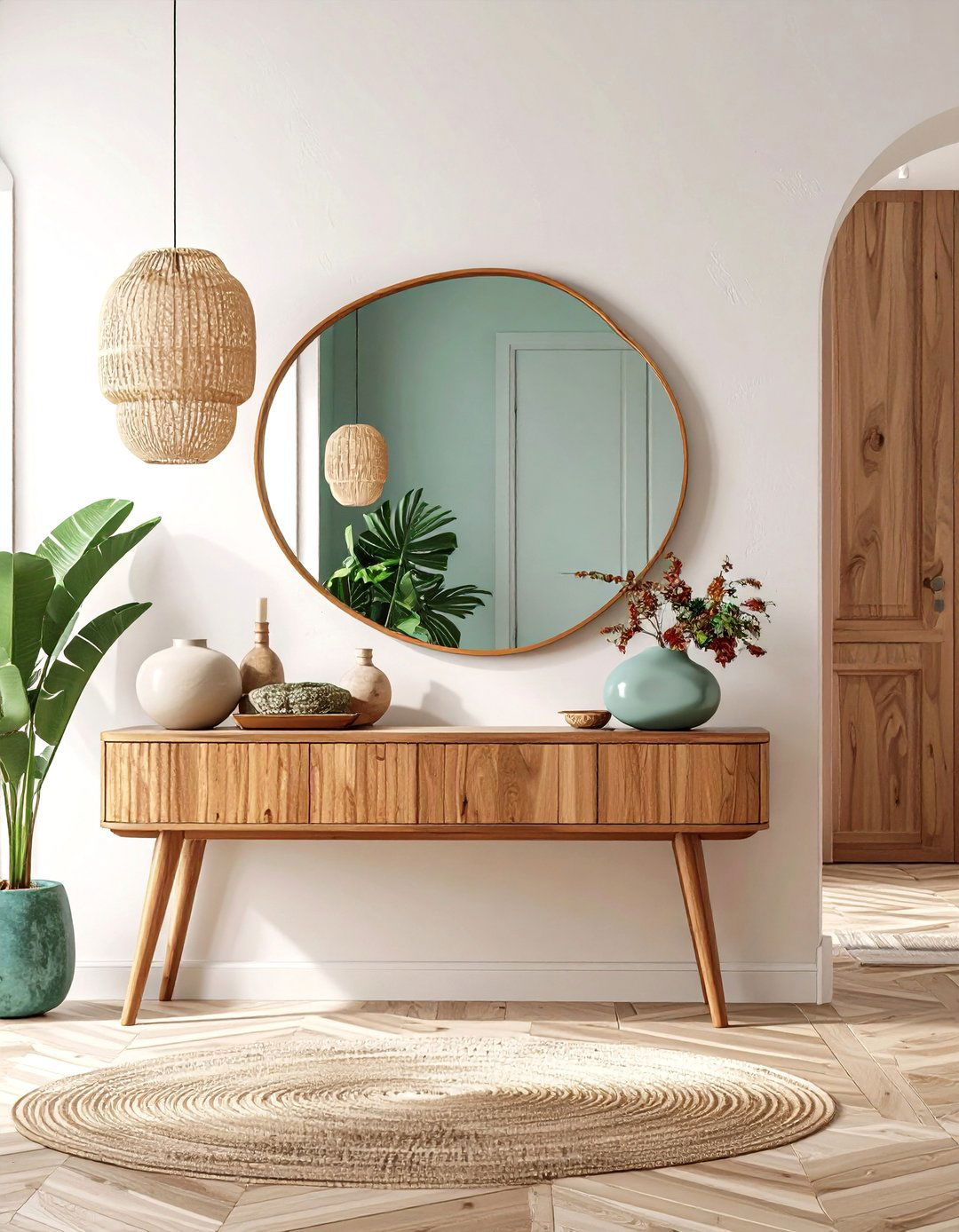
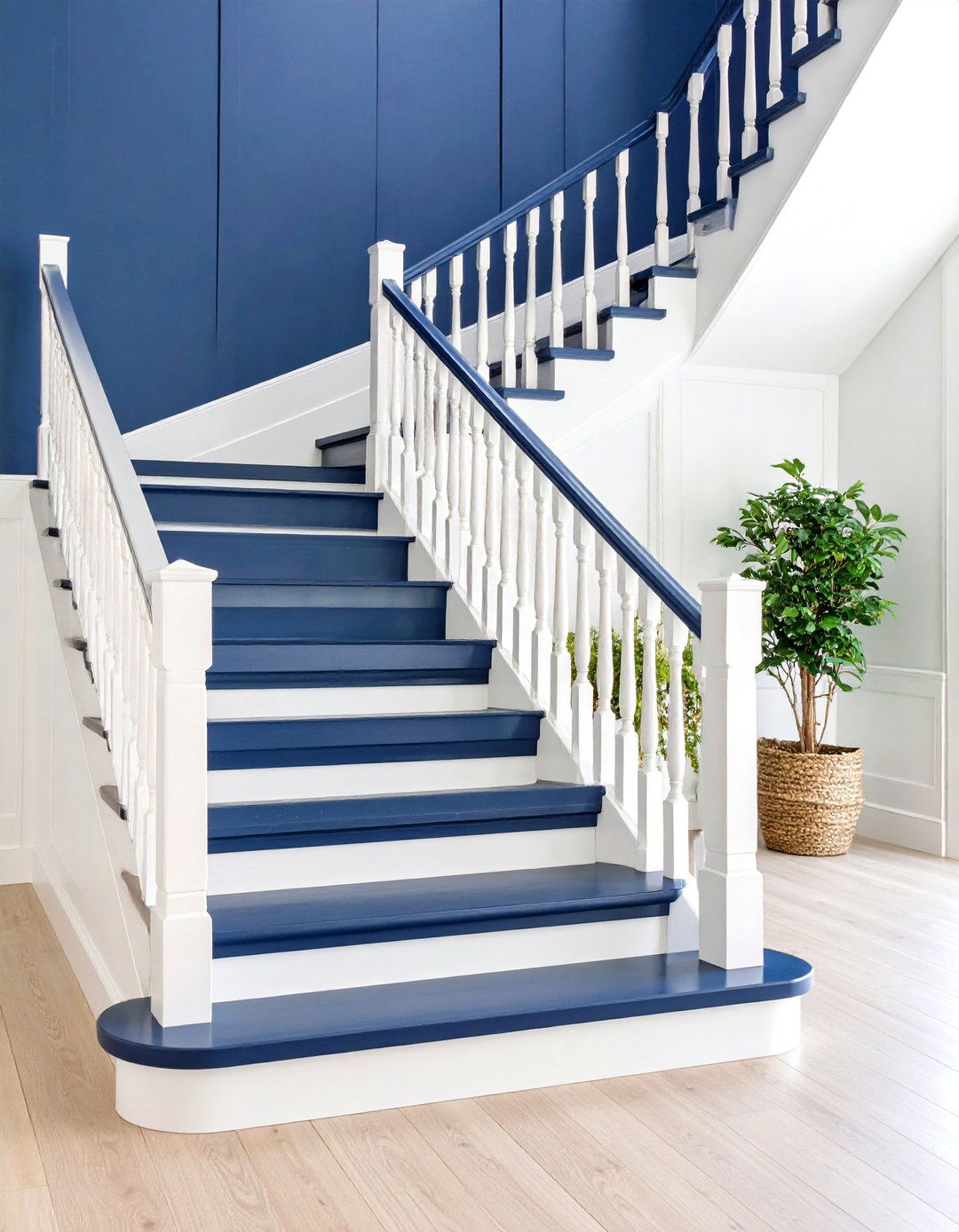

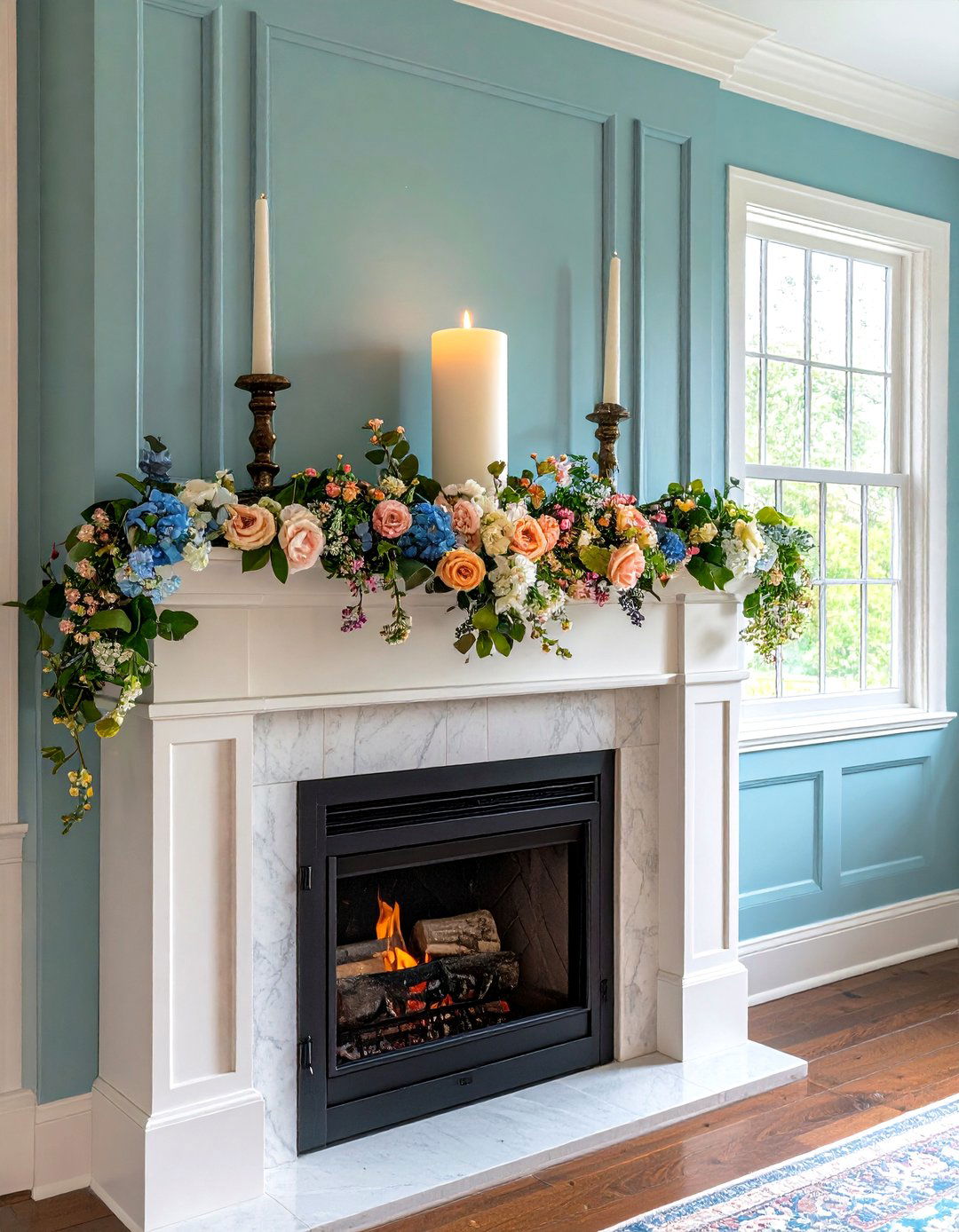
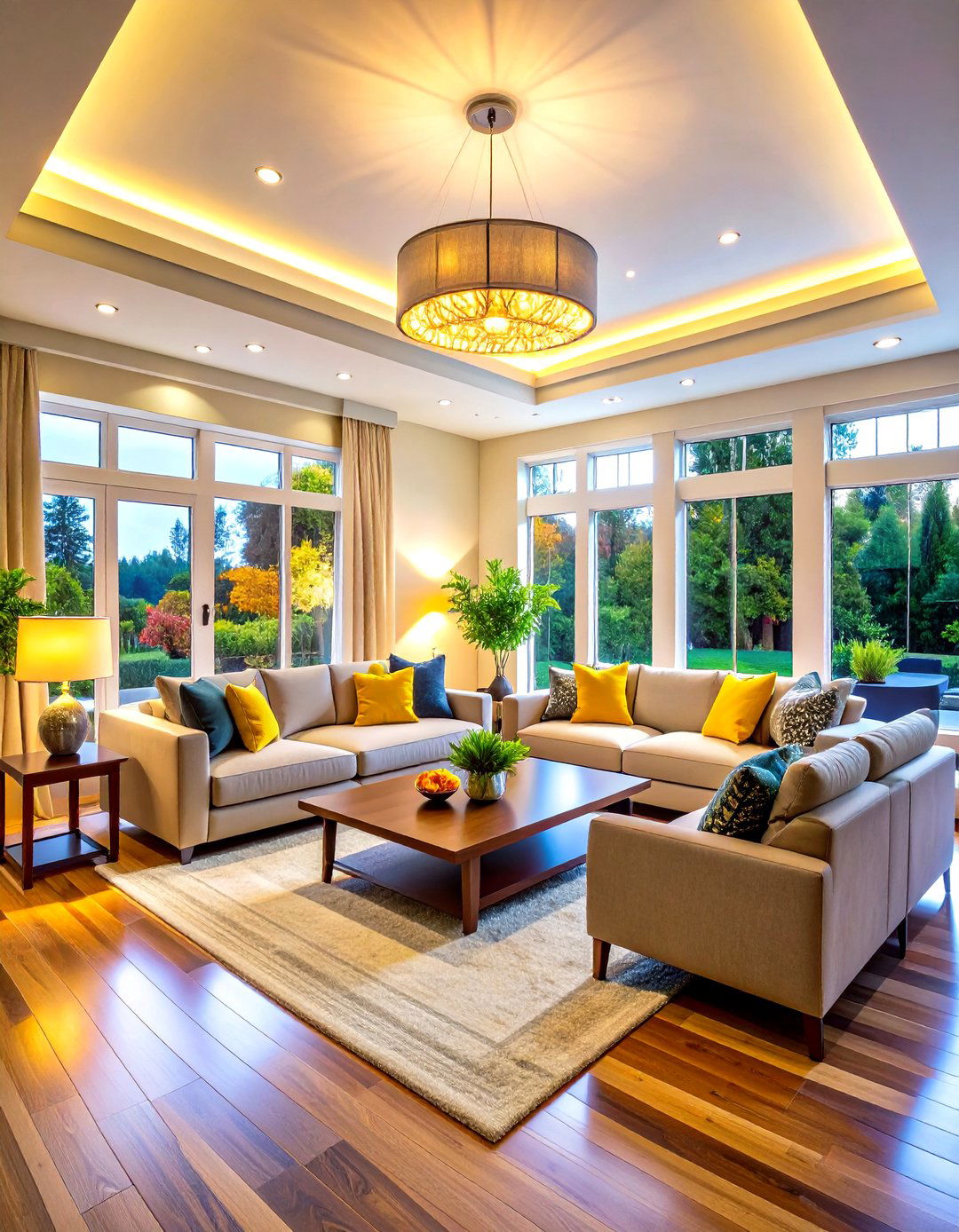
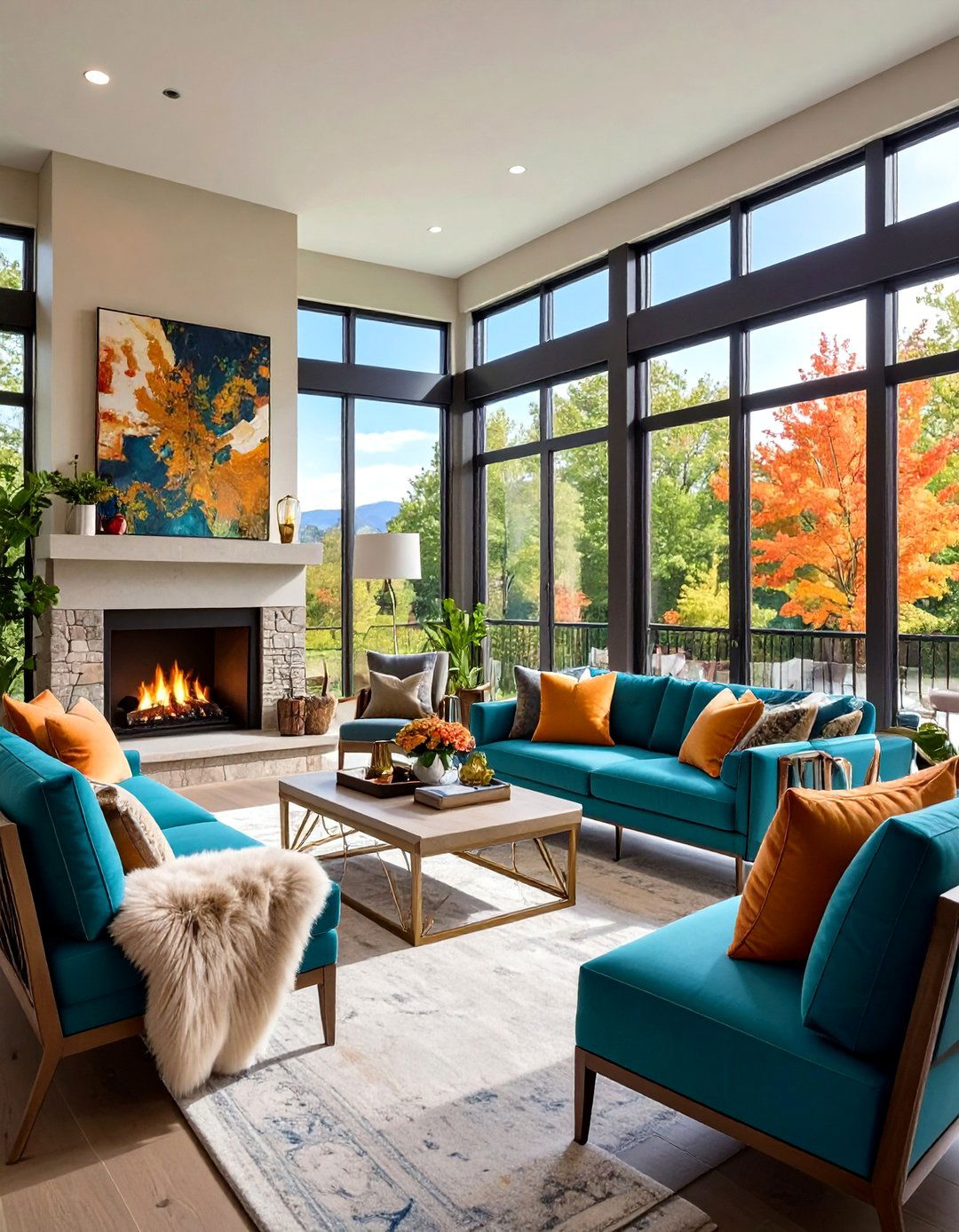

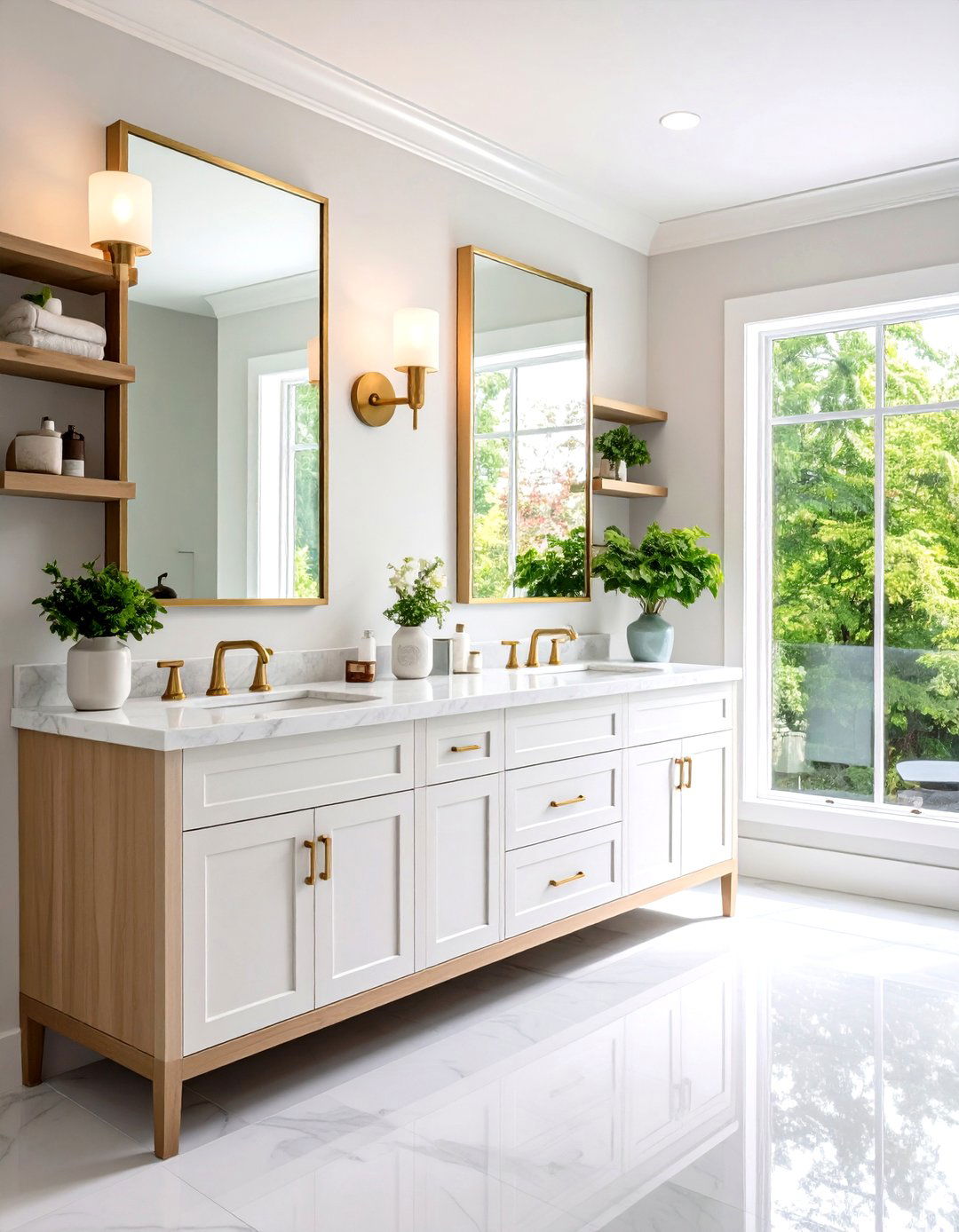

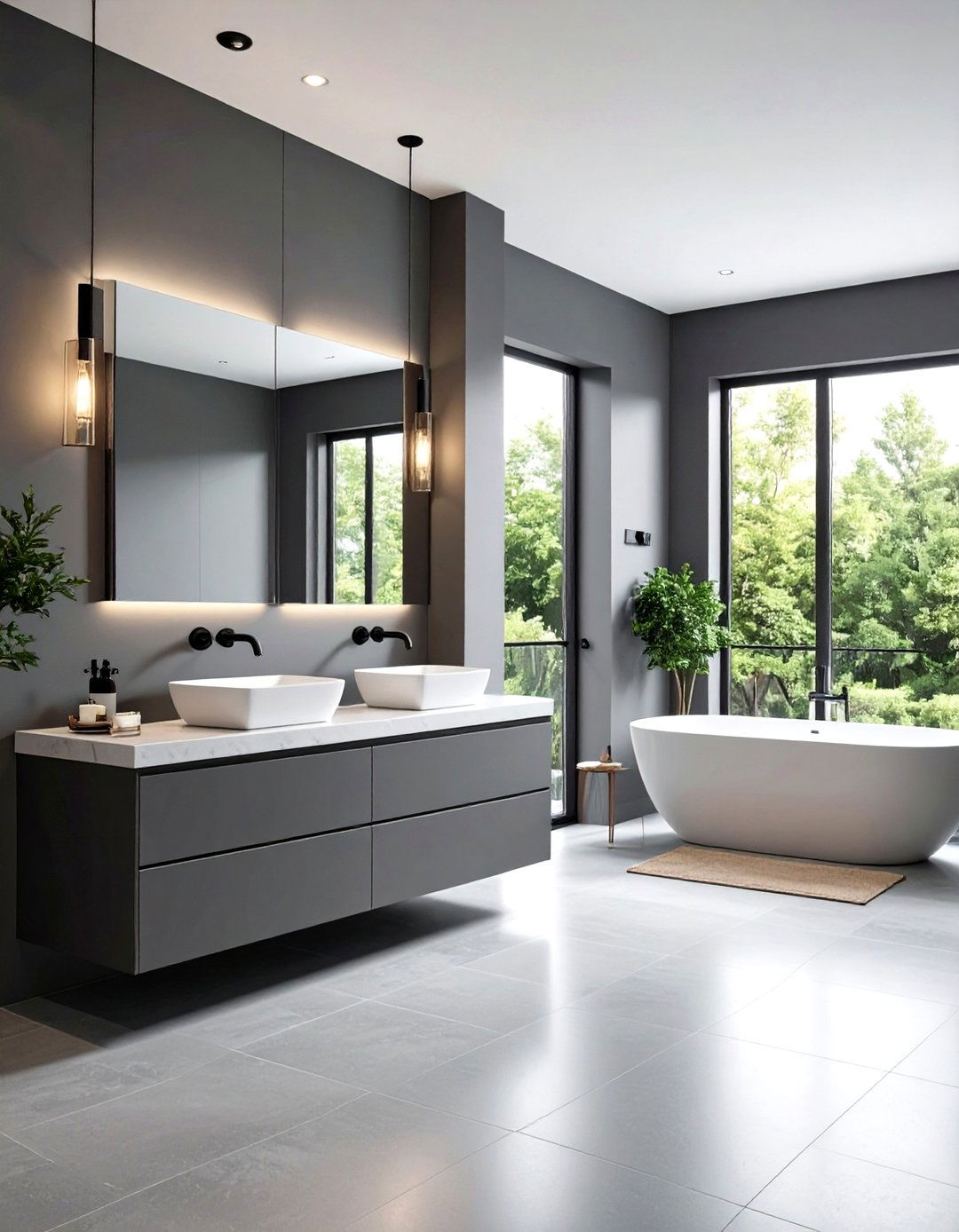
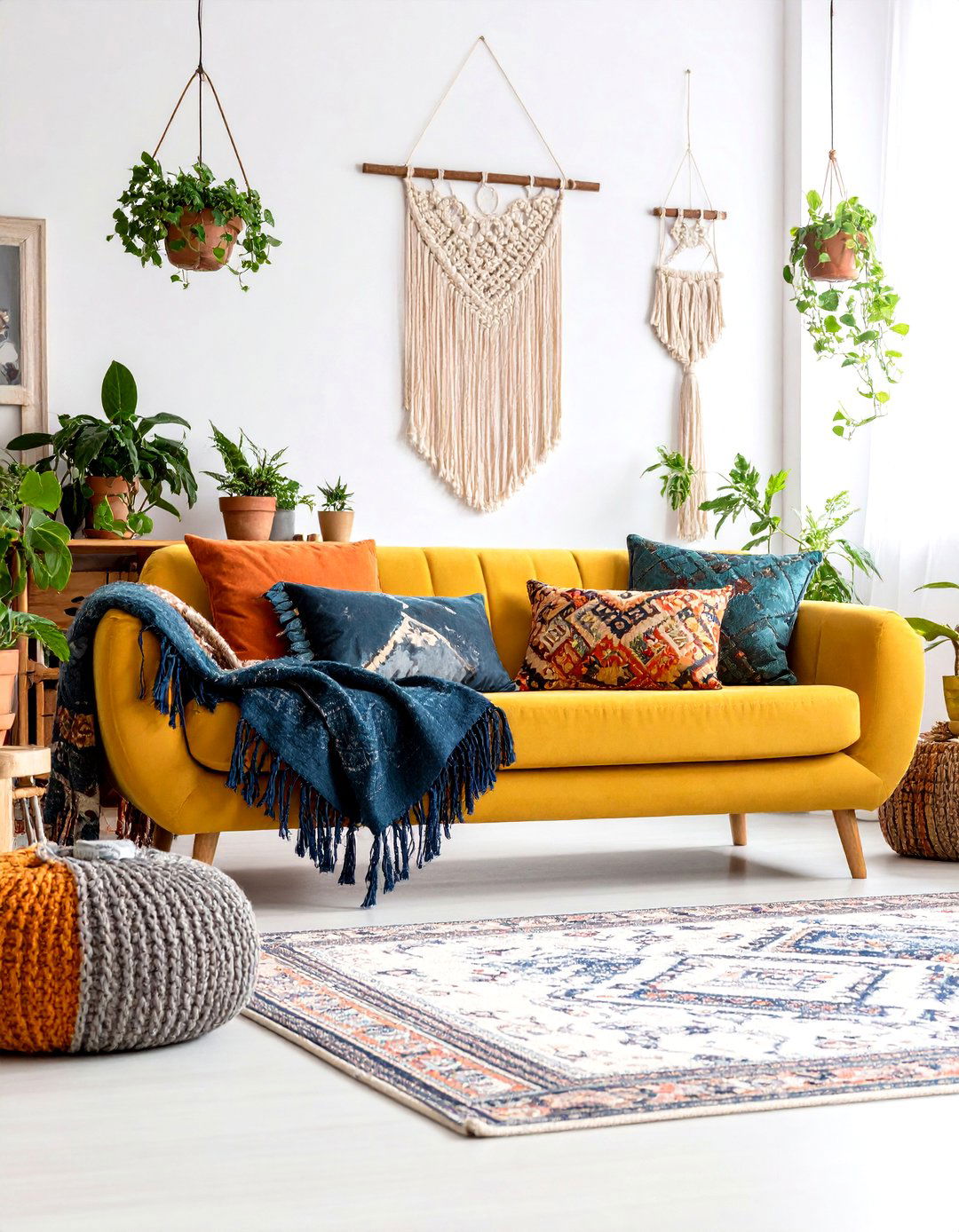

Leave a Reply